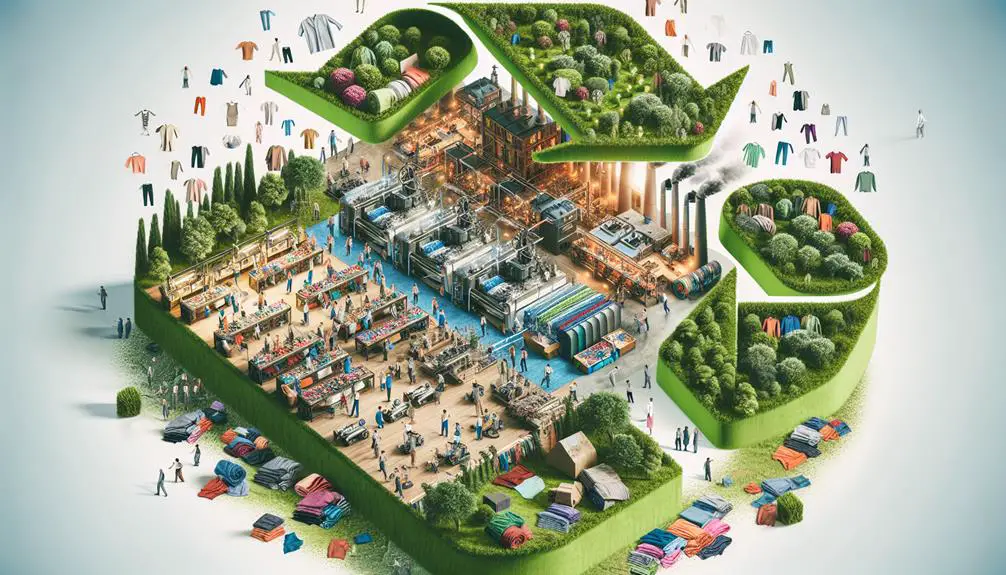Imagine a fashion company that's managed to recycle 95% of its textile waste through advanced recycling technologies. You might wonder how this is possible and what other innovative methods are driving such impressive results. From upcycling old clothes into trendy new items to creating biodegradable fabrics and adopting zero-waste design techniques, there's a lot happening in the world of sustainable fashion. You'll find that even digital fabric printing and circular fashion models are reshaping how we think about clothing production. Curious about how these innovations could change the entire industry?
Table of Contents
Key Takeaways
- Advanced recycling technologies convert discarded fabrics into reusable fibers for new products.
- Upcycling fashion trends promote DIY clothing and sustainable fabric choices to minimize textile waste.
- Biodegradable materials like hemp and bamboo naturally decompose, reducing long-term waste.
- Zero-waste design techniques create garments without fabric waste, utilizing innovative patterns.
- Circular fashion models, including rental programs and clothing swaps, encourage reuse and recycling.
Advanced Recycling Technologies
Advanced recycling technologies are revolutionizing how we handle textile waste. By employing cutting-edge textile to fiber processes, you can transform discarded fabrics into reusable fibers, minimizing the need for virgin materials. These advanced methods don't just break textiles down; they purify and prepare them for reincorporation into new products, ensuring quality and sustainability.
Closed loop systems stand at the forefront of this revolution. In these systems, waste becomes a resource, seamlessly integrating back into the production cycle. You can envision a world where the lifecycle of fabrics doesn't end in landfills but continues in a perpetual, eco-friendly loop. This approach notably reduces environmental impact and conserves resources.
Effective textile waste management hinges on meticulous waste stream analysis. By understanding the composition and volume of textile waste, you can optimize recycling processes and improve efficiency. Analyzing the waste stream allows for targeted interventions, ensuring that every possible fiber is recovered and reused. This precise approach not only enhances sustainability but also drives innovation in recycling technologies.
Upcycling Fashion Trends
You can reduce textile waste by exploring upcycling fashion trends.
Try DIY upcycled clothing ideas, choose sustainable fabric options, and embrace vintage clothing revival.
These practices not only help the environment but also let you express your unique style.
DIY Upcycled Clothing Ideas
Transforming old garments into fashionable new pieces is a creative way to reduce textile waste and express your unique style.
Start with thrifted denim; you can turn a pair of old jeans into trendy shorts, a chic skirt, or even a stylish tote bag. The possibilities are endless and allow you to customize each piece to fit your aesthetic perfectly.
Repurposed sweaters can become cozy mittens, beanies, or even a new patchwork sweater, combining different colors and textures for a unique look.
Vintage tees are another goldmine for upcycling. You can cut and sew them into trendy crop tops, tank tops, or even transform them into pillow covers for a retro touch to your home decor.
Don't forget about DIY accessories; using leftover fabric scraps, you can create headbands, scrunchies, or even fabric-covered buttons to add flair to any outfit.
Sustainable Fabric Options
While upcycling old garments offers a fantastic way to reduce waste, selecting sustainable fabric options for new projects can further enhance your eco-friendly fashion efforts. Opting for eco-conscious textiles not only minimizes environmental impact but also supports innovative production methods that prioritize the planet.
When choosing materials, consider fabrics like organic cotton, bamboo, and hemp. These choices typically involve ethical sourcing and reduced pesticide use, making them superior picks for sustainable fashion. Recycled polyester is another excellent substitution, crafted from post-consumer plastic waste, reducing the reliance on virgin resources.
Innovative production methods are revolutionizing the textile industry. For instance, Tencel, made from sustainably sourced wood pulp, utilizes a closed-loop process that recycles water and solvents. Similarly, Piñatex, derived from pineapple leaf fibers, offers a cruelty-free leather alternative while making use of agricultural waste.
To truly excel in the art of sustainable fashion, always confirm the ethical sourcing of your selected fabrics. Look for certifications like Global Organic Textile Standard (GOTS) or OEKO-TEX to guarantee that your materials meet stringent environmental and social criteria.
Vintage Clothing Revival
Embracing vintage clothing revival not only injects unique, nostalgic flair into your wardrobe but also markedly reduces textile waste by giving pre-loved garments a second life. By upcycling fashion trends, you can transform retro reimagined pieces into modern, stylish outfits that exude fashion nostalgia.
Thrifting treasures from local shops or online platforms allows you to curate a collection of vintage vibes that are both eco-friendly and fashionable. Beyond individual style, this practice notably cuts down on the environmental impact of fast fashion, promoting sustainability and conscious consumerism.
Consider these benefits of vintage clothing revival:
| Benefit | Description |
|---|---|
| Environmental Impact | Reduces waste and lowers carbon footprint |
| Unique Style | Access to one-of-a-kind pieces that stand out |
| Cost-Effective | Often more affordable than new, high-end garments |
Biodegradable Materials
You can play a vital role in reducing textile waste by choosing biodegradable materials. Natural fiber alternatives and compostable fabric technologies offer eco-friendly options that break down more easily.
These materials not only lessen environmental impact but also promote a more sustainable fashion industry.
Natural Fiber Alternatives
Switching to natural fiber alternatives like organic cotton and hemp can greatly reduce textile waste and environmental impact. Hemp textiles and bamboo fabrics are excellent choices due to their durability and biodegradability. Hemp, in particular, grows quickly and requires fewer resources compared to conventional cotton, making it a sustainable option. Bamboo fabrics, known for their softness and breathability, are also biodegradable, offering a comfortable yet eco-friendly solution.
Organic cotton and linen blends are other fantastic options. Organic cotton is grown without harmful pesticides, reducing environmental damage and promoting healthier soil. When blended with linen, which is derived from the resilient flax plant, you get a strong, long-lasting fabric that's perfect for eco-conscious consumers.
Here's a comparison to help you visualize:
| Material | Benefits | Environmental Impact |
|---|---|---|
| Hemp Textiles | Durable, Biodegradable | Low water use, rapid growth |
| Bamboo Fabrics | Soft, Breathable, Biodegradable | Fast-growing, renewable |
| Organic Cotton | Pesticide-free, Soft | Healthier soil, less toxic runoff |
| Linen Blends | Strong, Long-lasting, Biodegradable | Minimal water use, sustainable |
| Organic Cotton + Linen | Durable, Eco-friendly | Reduced pesticide use, resilient |
Compostable Fabric Technologies
Innovative compostable fabric technologies are paving the way for a more sustainable future in the textile industry. By embracing soil friendly textiles, you can be part of the eco-conscious fashion movement that prioritizes both style and sustainability. These fabrics break down naturally, returning valuable nutrients to the earth and ensuring sustainable disposal.
Consider these three cutting-edge compostable fabric technologies:
- Hemp and Linen: These natural fibers aren't only durable but also fully biodegradable. When their life cycle ends, they decompose quickly without leaving harmful residues, making them ideal for green wardrobe choices.
- Bamboo Fabric: Known for its softness and breathability, bamboo fabric is another excellent option. It decomposes efficiently, enriching the soil while reducing landfill waste.
- Tencel (Lyocell): Produced from sustainably sourced wood pulp, Tencel is celebrated for its environmental footprint. It's compostable, so it returns to nature without any synthetic by-products.
Zero-Waste Design
Zero-waste design focuses on creating garments that generate no fabric waste during production. By embracing this innovative approach, you can greatly contribute to textile recycling and waste reduction. Imagine designing a dress where every inch of fabric serves a purpose, leaving no scraps behind. This meticulous process not only conserves resources but also sets a new standard for sustainable fashion.
Zero-waste techniques often involve creative pattern-making and strategic cutting, ensuring that each piece of fabric is utilized. You'll find that embracing these methods can lead to unique and avant-garde designs, setting you apart in the fashion industry. Here's a quick comparison to help you understand the benefits:
| Traditional Design | Zero-Waste Design |
|---|---|
| Generates fabric scraps | No fabric waste |
| Limited by standard patterns | Encourages innovative patterns |
| Higher material costs | Maximizes fabric use |
Digital Fabric Printing
Digital fabric printing revolutionizes the way you create and customize textiles, offering endless possibilities for sustainable fashion. By embracing this technology, you can greatly reduce textile waste and enhance your design capabilities.
Eco friendly printing techniques minimize the use of water and chemicals, making your production process much greener compared to traditional methods.
With digital fabric printing, you can produce innovative designs that are both intricate and unique, without the limitations of conventional printing. This method allows you to print on demand, which means you only create what you need, significantly cutting down on excess inventory and waste.
Consider these advantages of digital fabric printing:
- Precision and Customization: You can achieve high levels of detail and vibrant colors, allowing for personalized and intricate designs that stand out.
- Sustainability: Eco friendly printing reduces the environmental impact, using less water and fewer chemicals, aligning with your commitment to sustainable fashion.
- Efficiency: The ability to print on demand means you avoid overproduction, reducing waste and optimizing resources.
Circular Fashion Models
Circular fashion models transform the industry by designing products with their entire lifecycle in mind, promoting reuse, recycling, and reducing waste. You can engage in textile rental programs, which allow you to enjoy fashion without the commitment of ownership. This not only saves money but also guarantees garments are worn to their full potential. Clothing swaps are another excellent way to refresh your wardrobe while keeping textiles in circulation.
By adopting closed loop systems, the fashion industry can reclaim textiles at the end of their life, reprocess them, and produce new products. Textile reclamation involves collecting and sorting used textiles so they can be recycled or repurposed, reducing the need for virgin materials. This holistic approach ensures that every piece of clothing has a purpose beyond its initial use.
Here's how different circular fashion initiatives compare:
| Initiative | Benefits |
|---|---|
| Textile Rental Programs | Reduces waste, cost-effective, extends garment lifecycle |
| Clothing Swaps | Promotes community engagement, reduces need for new purchases |
| Closed Loop Systems | Minimizes waste, encourages sustainable production practices |
| Textile Reclamation | Reduces landfill impact, supports material innovation and recycling |
Sustainable Dyeing Techniques
Sustainable dyeing techniques greatly reduce the environmental impact of textile production by using less water and non-toxic chemicals. You can adopt these methods to make your textile operations more eco-friendly and efficient.
Let's immerse into three main practices that are transforming the industry:
- Eco-Friendly Pigments: Opt for natural dyes derived from plants, minerals, and other organic sources. These pigments aren't only biodegradable but also free from harmful substances, ensuring that your products are safe for both the environment and consumers.
- Water-Saving Methods: Traditional dyeing processes consume a lot of water, but innovative techniques like digital printing and air dyeing drastically cut water usage. By implementing these methods, you'll reduce water waste and lower your operational costs.
- Closed-Loop Systems: In these systems, water and dye are recycled and reused multiple times. This approach minimizes waste and reduces the need for fresh water and new dye materials. It's a sustainable way to keep your processes lean and green.
Frequently Asked Questions
How Can Consumers Contribute to Reducing Textile Waste at Home?
You can contribute to reducing textile waste by recycling textiles, upcycling fabrics, and making eco-friendly choices. Embrace sustainable fashion, repair instead of discard, and choose quality over quantity to make a substantial impact.
What Role Do Government Policies Play in Minimizing Textile Waste?
Government regulations are essential in minimizing textile waste. You need robust policies that incentivize sustainable practices and mandate industry collaboration. When policies align with environmental goals, they drive innovation and accountability within the textile industry.
How Does Textile Waste Impact Global Landfill Capacity?
Did you know textile waste takes up about 5% of global landfill space? This landfill impact raises global awareness about the urgent need to address the issue and implement effective waste management strategies to preserve our environment.
Are There Any Financial Incentives for Companies to Reduce Textile Waste?
Yes, there are financial benefits for companies to reduce textile waste. By embracing corporate responsibility, you can enjoy cost savings, tax incentives, and enhanced brand loyalty, ultimately boosting your bottom line and sustainable reputation.
What Educational Initiatives Help Raise Awareness About Textile Waste Reduction?
You'll be amazed by how school programs, workshops, community events, and campaigns effectively raise awareness about textile waste reduction. These initiatives empower you to make impactful changes and inspire others to join the cause.
- How Does Ring Spun Cotton Affect Garment Fit and Shape Retention? - August 13, 2024
- What Are the Challenges in Producing Ring Spun Cotton? - August 13, 2024
- Is Ring Spun Cotton Suitable for Plus-Size Clothing? - August 13, 2024







